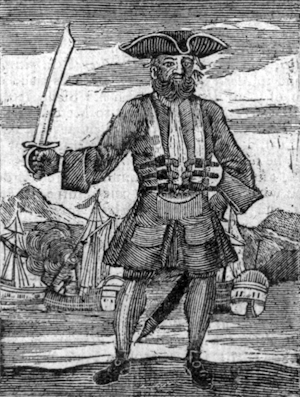 Most of the information we have available to us about the infamous and mysterious pirate known as Blackbeard is somewhat unreliable. Due to his estimated age when he met his death of between 35 and 40 years old, it is believed he was born circa 1680. What is certain is the date died – 22 November 1718. He was commonly known as Edward Teach or Thatch, but other spellings of his name include Thach, Thack, Tack, and Theach, but all these names might have been pseudonyms he used in order to protect the family name. The name Teach was mentioned in the Boston News-Letter of the time, but it may have been a spelling error. Other sources use the name Thatch, especially those who knew him personally. He was described by Henry Bostock, captain of the merchant sloop Margaret, which was taken off Crab Island near Anguilla, as being tall and thin and possessed of an immense black beard. He was said to be a charismatic leader and a heavy drinker. Although claimed by some to be the Devil himself, he is never recorded as harming anyone himself before his last battle, instead relying on his terrifying reputation to scare his victims. Journalist and historian Colin Woodard wrote in the Smithsonian Magazine in 2014, “Despite his infamous reputation, Blackbeard was remarkably judicious in his use of force. In the dozens of eyewitness accounts of his victims, there is not a single instance in which he killed anyone prior to his final, fatal battle with the Royal Navy.”
Most of the information we have available to us about the infamous and mysterious pirate known as Blackbeard is somewhat unreliable. Due to his estimated age when he met his death of between 35 and 40 years old, it is believed he was born circa 1680. What is certain is the date died – 22 November 1718. He was commonly known as Edward Teach or Thatch, but other spellings of his name include Thach, Thack, Tack, and Theach, but all these names might have been pseudonyms he used in order to protect the family name. The name Teach was mentioned in the Boston News-Letter of the time, but it may have been a spelling error. Other sources use the name Thatch, especially those who knew him personally. He was described by Henry Bostock, captain of the merchant sloop Margaret, which was taken off Crab Island near Anguilla, as being tall and thin and possessed of an immense black beard. He was said to be a charismatic leader and a heavy drinker. Although claimed by some to be the Devil himself, he is never recorded as harming anyone himself before his last battle, instead relying on his terrifying reputation to scare his victims. Journalist and historian Colin Woodard wrote in the Smithsonian Magazine in 2014, “Despite his infamous reputation, Blackbeard was remarkably judicious in his use of force. In the dozens of eyewitness accounts of his victims, there is not a single instance in which he killed anyone prior to his final, fatal battle with the Royal Navy.”
Little known about his early life. In traditional narratives he is said to have come from Bristol, which was England’s second biggest city at the time, possibly born into a wealthy merchant family. Another theory suggests he originated from Jamaica and had a wealthy background,. It is also possible he moved there with his family from Bristol. Historian Baylus Brooks in his book Blackbeard Reconsidered: Mist’s Piracy, Thache’s Genealogy has found evidence that he might have had family living in Jamaica. There are also a plausible claim made by the Blackbeard researcher Kevin Duffus that Teach was from North Carolina, although this theory generally not accepted by most historians. It is generally accepted that he fought as a privateer in The Spanish War of Succession and was based out of Jamaica, but seems to have never been given command of a ship. Whether from Jamaica or England he was well educated and could read and write, which couldn’t be said of most seamen of the time. After the war was over he moved to Nassau, where he met the pirate captain Benjamin Hornigold and served under him for a while.
Blackbeard’s early pirating career
It is widely thought that Hornigold placed Teach in command of a sloop that he had captured, and the two engaged together in numerous acts of piracy. In 1715, they committed their first unlawful act when they plundered the goods from the Spanish treasure fleet which sank in a storm off the coast of Florida. England and Spain were now at peace, so it was considered an affront to the Spanish crown. For the next two years they sailed along east coast of North America, where they captured dozens of ships. One prize was a vessel carrying 120 barrels of flour out of Havana, shortly after which they took 100 barrels of wine from a sloop out of Bermuda. A few days later they stopped a vessel sailing from Madeira to Charles Town, South Carolina, and it was at this time that Blackbeard first became known as a renowned pirate captain. In September 1717, they encountered Stede Bonnet, whose self-financed ship Revenge Blackbeard took over command of. Not long after, they captured a French privateering slave ship, La Concord, which Blackbeard renamed the Queen Anne’s Revenge, which became probably the most formidable pirate ship of all the Golden Age. Further acts or piracy included the seizing of the sloops Robert of Philadelphia and Good Intent of Dublin in October 1717, which were both relieved of their cargo. In late November, he captured the Great Allen near Saint Vincent, and after a lengthy engagement, the large and well-armed merchant ship was forced to surrender. Blackbeard ordered her to be moved closer to the shore, where he removed her crew and emptied her cargo holds, after which he burned and sank the ship. Benjamin Hornigold retired from piracy toward the end of 1717 after refusing to attack an English ship, taking two vessels with him. He later accepted the King’s pardon and became a pirate hunter.
Blackbeard’s solo career
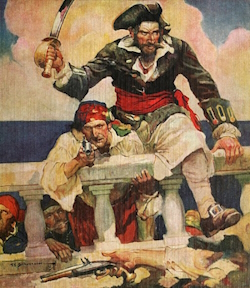 In December 1717, Blackbeard stopped the merchant sloop Margaret off the coast of Crab Island, near Anguilla. Her captain, Henry Bostock, and his crew were held for about eight hours, during which time they watched helplessly as their sloop was plundered. Bostock was returned unharmed to Margaret and allowed to leave with his crew. Not much is known about Blackbeard’s movements from the end of 1717 to March 1718, but it is believed he sailed to the Spanish Main, where possibly planned to capture a Spanish treasure fleet. There he terrorized Spanish shipping and allegedly earned himself the name ‘El Gran Diablo’. In March 1718, while taking on water at Turneffe Island east of Belize, his ships spotted the Jamaican logwood-cutting sloop Adventure making for the harbour. She was stopped and her captain, David Harriot, invited to join the pirates, he and his crew accepting the invitation, either willingly or unwillingly. Blackbeard sent over a crew to sail Adventure, making Israel Hands its captain. Harriot later testified that Blackbeard had intentionally run the Queen Anne’s Revenge and Adventure aground, which was confirmed by Ignatius Pell, who had been Captain Stede Bonnet’s boatswain, although whether this was true or not is still debated among historians. On 9 April Teach’s fleet captured some sloops and a larger ship called Protestant Caesar near the Bay of Honduras. After looting them, Blackbeard ordered one sloop and the Protestant Caesar to be burned because they were from Boston, which he held a grudge against after several pirates had been tried and hanged there. He then sailed to Grand Cayman and Havana, where he captured some smaller vessels. After that, his small fleet sailed to the wrecks of the 1715 Spanish fleet off the eastern coast of Florida, although there was by now little to be salvaged there. Next he proceeded north to the port of Charles Town, South Carolina, allegedly attacking three vessels along the way.
In December 1717, Blackbeard stopped the merchant sloop Margaret off the coast of Crab Island, near Anguilla. Her captain, Henry Bostock, and his crew were held for about eight hours, during which time they watched helplessly as their sloop was plundered. Bostock was returned unharmed to Margaret and allowed to leave with his crew. Not much is known about Blackbeard’s movements from the end of 1717 to March 1718, but it is believed he sailed to the Spanish Main, where possibly planned to capture a Spanish treasure fleet. There he terrorized Spanish shipping and allegedly earned himself the name ‘El Gran Diablo’. In March 1718, while taking on water at Turneffe Island east of Belize, his ships spotted the Jamaican logwood-cutting sloop Adventure making for the harbour. She was stopped and her captain, David Harriot, invited to join the pirates, he and his crew accepting the invitation, either willingly or unwillingly. Blackbeard sent over a crew to sail Adventure, making Israel Hands its captain. Harriot later testified that Blackbeard had intentionally run the Queen Anne’s Revenge and Adventure aground, which was confirmed by Ignatius Pell, who had been Captain Stede Bonnet’s boatswain, although whether this was true or not is still debated among historians. On 9 April Teach’s fleet captured some sloops and a larger ship called Protestant Caesar near the Bay of Honduras. After looting them, Blackbeard ordered one sloop and the Protestant Caesar to be burned because they were from Boston, which he held a grudge against after several pirates had been tried and hanged there. He then sailed to Grand Cayman and Havana, where he captured some smaller vessels. After that, his small fleet sailed to the wrecks of the 1715 Spanish fleet off the eastern coast of Florida, although there was by now little to be salvaged there. Next he proceeded north to the port of Charles Town, South Carolina, allegedly attacking three vessels along the way.
The blockade of Charles Town
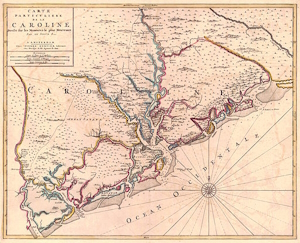 Blackbeard’s ships arrived at Charles Town, which is believed to have been known as Charleston from 1719 onwards, on 22 May 1718. The town was established in 1670 and had approximately 5000 inhabitants. It was the capital of South Carolina and thrived from the export of rice. Many people there harboured sympathies for pirates. Once there, Blackbeard put a complete stop to local commerce for over a week. Surprisingly, he wasn’t after treasure but a chest of medicine to the value of 400 pounds, and it is thought that either he or members of his crew were suffering from syphilis. He captured about nine ships of varying sizes, including a slave ship, from which he recruited some of the slaves into his crew. He threatened to murder all of the captives if he didn’t get what he demanded. Two pirates and one of the prisoners were sent in a boat to make the demand, but it capsized on the way. After being stranded on a small island, the three men had to make a raft and were eventually found by fishermen. By now the deadline had already passed. Blackbeard granted the town two more days, which also passed. Once informed, the governor, Robert Johnson, readily agreed to the demand, but his reply was delayed when the two pirates got drunk after meeting associates in the town. Blackbeard entered the harbour after becoming angry and impatient. The pirates then got the chest they wanted, and the Governor even offered Blackbeard a pardon if he surrendered himself, but this the pirate captain rejected. The prisoners were released after being stripped of their valuables and fancy clothing and Blackbeard’s fleet of vessels left with the chest, some rice, and about 1000 pounds in cash. Blackbeard probably deemed the town too risky to sack even if he had wanted to, as naval ships, although none being present at the time, could have arrived at any time. There would have also been the formidable fort and the veteran militia to deal with, so a blockade was the safest bet. After his departure, Governor Johnson sent two sloops to hunt the pirates down, but they never found their quarry.
Blackbeard’s ships arrived at Charles Town, which is believed to have been known as Charleston from 1719 onwards, on 22 May 1718. The town was established in 1670 and had approximately 5000 inhabitants. It was the capital of South Carolina and thrived from the export of rice. Many people there harboured sympathies for pirates. Once there, Blackbeard put a complete stop to local commerce for over a week. Surprisingly, he wasn’t after treasure but a chest of medicine to the value of 400 pounds, and it is thought that either he or members of his crew were suffering from syphilis. He captured about nine ships of varying sizes, including a slave ship, from which he recruited some of the slaves into his crew. He threatened to murder all of the captives if he didn’t get what he demanded. Two pirates and one of the prisoners were sent in a boat to make the demand, but it capsized on the way. After being stranded on a small island, the three men had to make a raft and were eventually found by fishermen. By now the deadline had already passed. Blackbeard granted the town two more days, which also passed. Once informed, the governor, Robert Johnson, readily agreed to the demand, but his reply was delayed when the two pirates got drunk after meeting associates in the town. Blackbeard entered the harbour after becoming angry and impatient. The pirates then got the chest they wanted, and the Governor even offered Blackbeard a pardon if he surrendered himself, but this the pirate captain rejected. The prisoners were released after being stripped of their valuables and fancy clothing and Blackbeard’s fleet of vessels left with the chest, some rice, and about 1000 pounds in cash. Blackbeard probably deemed the town too risky to sack even if he had wanted to, as naval ships, although none being present at the time, could have arrived at any time. There would have also been the formidable fort and the veteran militia to deal with, so a blockade was the safest bet. After his departure, Governor Johnson sent two sloops to hunt the pirates down, but they never found their quarry.
Blackbeard’s later pirating career
At some point Blackbeard must have heard about the King’s pardon and that Woodes Rogers was heading towards the Caribbean to reclaim New Providence for the Crown. It was then he decided to careen his vessels, but in June 1718, two weeks after the blockade of Charles Town, the Queen Anne’s Revenge became caught on a sandbar near Beaufort, North Carolina and sank despite attempts to save her. The sloop Adventure attempted to rescue it was also stranded. A theory exists that it was done on purpose by Blackbeard to reduce the size of his crew and get more booty for himself. After this unfortunate incident, he presented himself to Governor Eden of North Carolina to accept the King’s pardon. At his time, he might have been considering becoming a privateer in the War of the Quadruple Alliance (1718-1720) against Spain, which had recently broke out. After accepting the pardon, he settled down at Bath Creek on Plum Point, North Carolina, where he allegedly married a young local woman. Meanwhile, the governor of Pennsylvania sent out two sloops to capture the pirates but was unsuccessful. The governor of Virginia, Alexander Spotswood, who didn’t trust the North Carolinians, wanted to prosecute Blackbeard despite him having accepted the pardon under the Proclamation for the Suppression of Pirates Act on the grounds that only deeds committed until 5th January 1718 could be overlooked. This clause was a stipulation to prevent pirates committing one last act of piracy before accepting the pardon. This didn’t concern Blackbeard, who probably believed the colonial authorities would waive this clause, although the attack on Charles Town was carried out five months after this deadline. There were also suspicions he had attacked, among others, a French ship, which Blackbeard claimed he had found abandoned. He claimed salvage rights on the vessel and its cargo of sugar and cocoa, and although confirmed by the Vice Admiralty Court to have been a shipwrecked vessel, the judge and governor in this case both profited from a share of the cargo, raising the question if Blackbeard had indeed captured it by force.
Blackbeard’s death
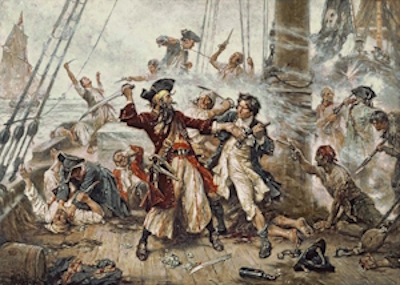
After parting company with Stede Bonnet and settling down in Bath Town, North Carolina, Blackbeard might have thought he was safe after he had accepted the royal pardon. Bent on putting an end to Blackbeard, Alexander Spotswood, the governor of Virginia, arranged for a party of soldiers and sailors to capture him, although North Carolina lay outside of his jurisdiction. Tipped off to Blackbeard’s whereabouts, Spotswood commandeered two sloops named Ranger and Jane and sent an expedition under naval lieutenant Robert Maynard with sixty men on the two sloops to capture the notorious pirate captain. Additionally, Captain Brand led a small force of soldiers overland. All were after the hundred pound bounty Spotswood had put on Blackbeard’s head. When the two sloops arrived at Ocracoke Island, where Blackbeard was believed to be, the pirate captain only had one remaining sloop left, which he had renamed Adventure. On 22 November 1718 a ferocious battle took place among the sandbars along the coast. Blackbeard had less than 30 men available to him at the time, and after a ruse, in which Maynard had hidden his men below deck and let the pirates board, Blackbeard and several of his crew were killed. Edward Teach’s head was taken to prove he was dead and to be able to claim the bounty of 100 pounds. Blackbeard’s head was later set on a spike at the entrance to the Chesapeake and James River in Virginia as a warning to any would-be pirates. Blackbeard’s body was thrown over board, but Maynard claimed the corpse had twenty sword cuts and five bullet wounds. Although various accounts disagree on the exact numbers, approximately ten of Maynard’s men and ten pirates died, and more than 20 sailors were wounded. There is a heated debate about the details of the combat, the Boston News-Letter offering a particularly colourful account of Blackbeard’s final moments to its readers. In addition to killing Edward Teach, Maynard took nine pirates prisoner, as well as the surviving crew who had remained on the Adventure or who had been on land during the fight. In total sixteen were captured, fourteen of whom were found guilty at their trial in Williamsburg, Virginia. Of the remaining two, one, a trader called Samuel Odell, proved that he had partaken of the fight out of necessity, having been on Teach’s ship only as a guest, and was not a pirate. The other, Israel Hands, was not present at the fight at all. He claimed that during a drinking session Teach had shot him in the knee, and that he was still covered by the royal pardon. The remaining pirates were hanged, then left to rot in gibbets along Williamsburg’s “Gallows Road”.
The Queen Anne’s Revenge
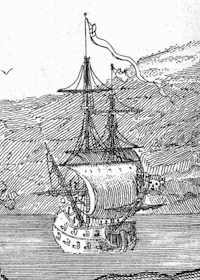 Although Blackbeard started his pirating career on a sloop, he was later to captain one of the most formidable pirate ships ever – The Queen Anne’s Revenge – which was originally a French privateering slave ship called La Concorde, captured in September 1717. It was a three-mast, fully rigged ship of 250 tons and sleek build. Extra gun ports were cut into the side and although the forecastle was removed the quarterdeck was retained, probably serving as a gun platform. The ship eventually carried 40 guns, although many of them might have been swivel guns, making her one of the most fearsome warships in the Caribbean. She was the flagship of Blackbeard fleet and always sailed with number of consort sloops. The ship was named after Queen Anne, the last Stuart monarch, revealing Blackbeard’s Jacobite sympathies. The ship met her end when she ran aground on a sandbar and sank off the coast of North Carolina in May of 1718, shortly after the blockading of Charleston’s harbour. In his deposition, the captain of a captured sloop, David Herriot, claims that Blackbeard intentionally grounded the Queen Anne’s Revenge and Adventure in order to break up the company, which by this time had grown to over 300 pirates.
Although Blackbeard started his pirating career on a sloop, he was later to captain one of the most formidable pirate ships ever – The Queen Anne’s Revenge – which was originally a French privateering slave ship called La Concorde, captured in September 1717. It was a three-mast, fully rigged ship of 250 tons and sleek build. Extra gun ports were cut into the side and although the forecastle was removed the quarterdeck was retained, probably serving as a gun platform. The ship eventually carried 40 guns, although many of them might have been swivel guns, making her one of the most fearsome warships in the Caribbean. She was the flagship of Blackbeard fleet and always sailed with number of consort sloops. The ship was named after Queen Anne, the last Stuart monarch, revealing Blackbeard’s Jacobite sympathies. The ship met her end when she ran aground on a sandbar and sank off the coast of North Carolina in May of 1718, shortly after the blockading of Charleston’s harbour. In his deposition, the captain of a captured sloop, David Herriot, claims that Blackbeard intentionally grounded the Queen Anne’s Revenge and Adventure in order to break up the company, which by this time had grown to over 300 pirates.
Blackbeard’s crew
Not much is know about many of Blackbeard’s crewmembers, although one prominent name was that of Israel Hands, who was also later featured in the novel Treasure Island. He was Blackbeard’s boatswain, who was given command of 10-gun sloop Adventure. In the 1724 A General History of Pirates the author claimed that Blackbeard shot him in the knee while playing cards. He was one of the few not to be hanged. Another one of the crew who survived Blackbeard’s demise was John Rose Archer, who became a fisherman after Blackbeard’s death, later returning to piracy again. His ship was taken over by pressed crewmen and he was convicted of piracy in Boston and hanged there in 1724. Another famous name is Black Caesar, although little is known about him it is thought he might have been an ex-slave. He was instructed to blow up Blackbeard’s sloop should they be defeated, but was overpowered and prevented from carrying out the task. He was hanged in Virginia. Another known name is that of William Howard, who was first Hornigold’s quartermaster, but then joined Blackbeard’s crew in 1717, quickly becoming his quartermaster. He was detained in Virginia and interrogated to Blackbeard’s whereabouts, but escaped hanging when the pardon of all pirates arrived just in time to save him. Blackbeard took on some Frenchmen after capturing, including several volunteers, when he captured La Concorde: the surgeon, the pilot, the master carpenter, and the cook among others. Another name worthy of mention is the gunner William Cunningham, who decided to stay in Nassau and later joined Charles Vane. He was captured and hanged by Woodes Rogers. The rest of Blackbeard’s numerous crew either died in battle, were hanged, or disappeared into obscurity.
Blackbeard’s flag
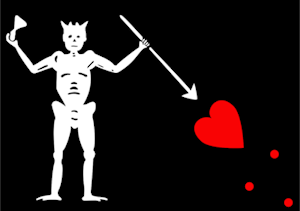 The authenticity of the flag attribued to Blackbeard portraying a skeleton with hourglass stabbing a heart is hotly disputed. There is no evidence that it was indeed ever used by him. The flag first appeared a 1912 academic journal The Mariner’s Mirror, but no mention was made of it being the flag Blackbeard used. It was first associated it with Blackbeard in the 1978 book Pirates of the Spanish Main. In the 1726 version of General History of Pirates Blackbeard’s flag depicted a skull possibly with two crossbones. Other accounts claim he flew an all black or an all red flag. A similar design of a skeleton stabbing a heart was later used by other pirates such as Ned Lowe.
The authenticity of the flag attribued to Blackbeard portraying a skeleton with hourglass stabbing a heart is hotly disputed. There is no evidence that it was indeed ever used by him. The flag first appeared a 1912 academic journal The Mariner’s Mirror, but no mention was made of it being the flag Blackbeard used. It was first associated it with Blackbeard in the 1978 book Pirates of the Spanish Main. In the 1726 version of General History of Pirates Blackbeard’s flag depicted a skull possibly with two crossbones. Other accounts claim he flew an all black or an all red flag. A similar design of a skeleton stabbing a heart was later used by other pirates such as Ned Lowe.
Blackbeard legacy
The idea of Blackbeard was much romanticised after his death and became the inspiration for an archetypal pirate in works of fiction across many genres. His manner and deeds were greatly exaggerated both by the press at the time and in later works of fiction in an attempt to attract readers. One claim, which might well be true, was that he tied lit fuses (slow matches) under his hat and to his hair to frighten his enemies. There are other stories which have no basis in truth such as Captain Johnson’s claim that he had 14 wives and engaged in orgies with them, even having them killed after he had tired of them. He was reported to be extremely violent and cruel but there’s no real evidence of this. Even after his death the myths persisted. For example, some recitals claim that the notorious pirate now roams the afterlife searching for his head for fear that his friends and the Devil will not recognise him. A North Carolinian tale even holds that Teach’s skull was used as the basis for a silver drinking chalice.
For a short visual summary of Blackbeard’s pirating career watch this interesting video by Captivating History.
If you are interested in the controversial debate about where Blackbeard comes from you can watch the two following interviews on The Pyratical Podcast. The first is with Baylus Brooks, who believes he originated from Jamaica, the second with Kevin Duffus, who claims he came from North Carolina.
